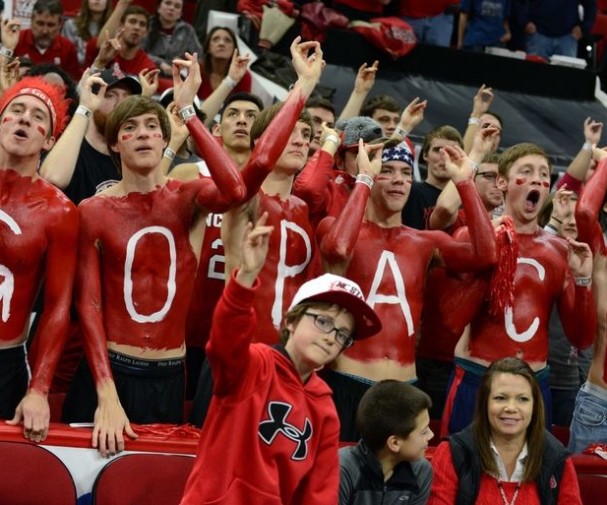(Mandatory Credit: Rob Kinnan-USA TODAY Sports)
I think I’ll take a minute to back up and discuss the classifications of “IN”, “BUBBLE”, and “OUT” that I give to each team in the ACC on a weekly basis. Obviously there are no NCAAT bids extended in January or February. So my classification of “IN” is supposed to mean that the team is on track to make the NCAAT and just has to keep playing at the level that got it to this point in the season. “BUBBLE” means that a team is close but needs to step up its game to be sure of getting an NCAAT bid. “OUT” doesn’t mean that there is no chance of a bid (especially in January), just that there is A LOT of work that needs to be done.
Sometime in the middle of the Great Herb Debate, I looked at the NCAAT bids to teams from the power conferences and tried to correlate a NCAAT bid solely to the team’s final RPI ranking. From that I got the RPI ranges that I use to grade each team. But life isn’t really that simple and one of the complicating issues that we’ve uncovered is that the NCAAT Selection Committee hates teams with losing conference records. I haven’t looked at other conferences, but for ACC teams we’ve seen that a losing conference record, a good RPI (Top 50), and a quick exit in the ACCT will land you in the NIT (Full discussion here). Conversely, ACC teams with a losing conference record, decent RPI, and an ACCT upset end up in the NCAAT (Full discussion here).
So when you’ve got a team with a Top 40 RPI ranking and a losing conference record, we end up with conflicting indicators. The team in question will either pick up the pace (ie Syracuse last year after starting 0-4 in conference) or will continue to lose and eventually their RPI will fall as shown in the examples above. So the open question is how should we classify these teams today? We could just use RPI and put them IN or put everyone with a losing conference record on the Bubble to be simple. But I think that I will try and take an individualized approach and judge each team based on their performance to date. So here goes nothing…
Wake Forest
With an RPI of 26 and an ACC record of 1-4, WF is nearly the perfect example of conflicting indicators. So let’s break down their season like this:

(Values from CBS because I like their game-by-game format better than ESPN’s.)
This table summarizes all losses and all Top 100 wins. I think that this table pretty much proves that WF is not a Top 50 team (regardless of the RPI math) since they are 0-7 against Top 50 teams. While it’s true that most of those games were away from home and most were against Top-20 teams, but I see no reason to give partial credit for a game that hasn’t been played yet and it’s not enough just to play a tough schedule. So WF is on the BUBBLE for today and until they beat someone worth discussing.
Pitt
With an RPI of 36 and an ACC record of 1-4, Pitt looks like a repeat of WF. But their breakdown shows an important difference:
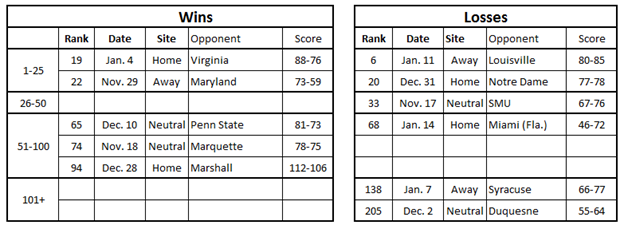
Those that have been around here for a while will already know that two Top-25 wins puts Pitt ahead of several of Herb’s NC State teams that ended up with an at-large NCAAT bid….along with a few horrible losses that harken back to Herb. But going into Selection Sunday, the big wins matter a lot more than the bad losses; mostly because everyone on the bubble has a few bad losses on their resume.
But Pitt illustrates why I started with definitions. IN denotes that you need to just keep doing what you’re doing. A 1-4 in conference play, Pitt needs to do a whole lot better than they’ve shown over the last two weeks. If Pitt had beaten Miami at home and were sitting at 2-3, I would have left them IN. But at 1-4, Pitt has a lot to prove before I can classify them any higher than the Bubble.
I hate to steal my own thunder, but when we get to the ACC Standings, we’ll see that both teams are fighting for a spot on ACCT Tuesday. Thus classifying them as being on the Bubble is probably being generous far beyond what they deserve.
RPI SUMMARY
So those discussions lead us to our summary table:
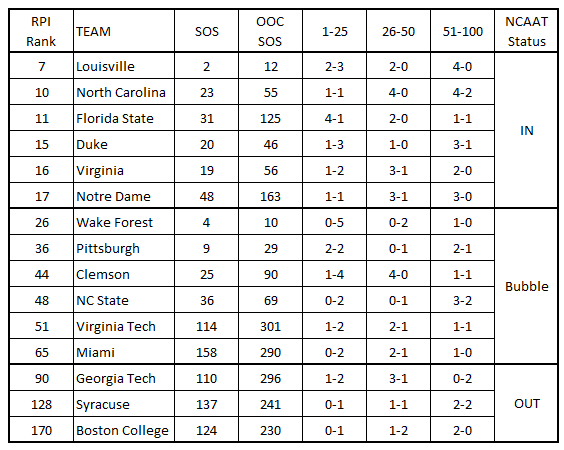
(Data from ESPN)
Duke is 1-2 since K’s surgery and 0-2 since Amile Jefferson got hurt again this year. They don’t have a mid-week game this week which seems to come at a good time for them. They host Miami on Sat and State on the next Monday. Jefferson is questionable for Miami, but anything less than 2-0 will likely get the natives restless (if they aren’t already there).
Since beating Duke, VT has lost three of four, with their loss to State looking worse and worse. But they have GT at home next and then at Clemson. As time goes on, we’ll see which game best describes the Hokies; the win against Duke or the loss to State.
Miami is hard team for me to get a read on. They looked great against State and looked like crap on the road at Syracuse. Maybe they’re just used to playing in an empty stadium. Two more road games this week (WF, Duke) will let us gather more information. They may ultimately prove to be better than State, WF, and Pitt; but you wouldn’t know that just by the RPI rankings. For now, their miserable OOC schedule works to minimize everyone’s opinion of them. BTW, Miami’s two Top-50 wins are against State and Pitt which are rapidly losing any value as a talking point.
TREND GRAPHS
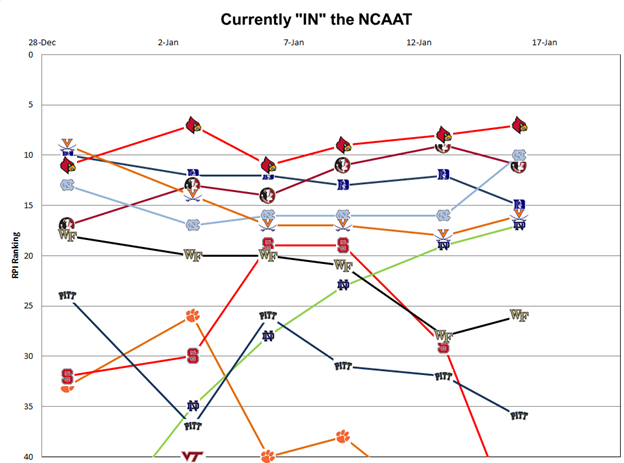
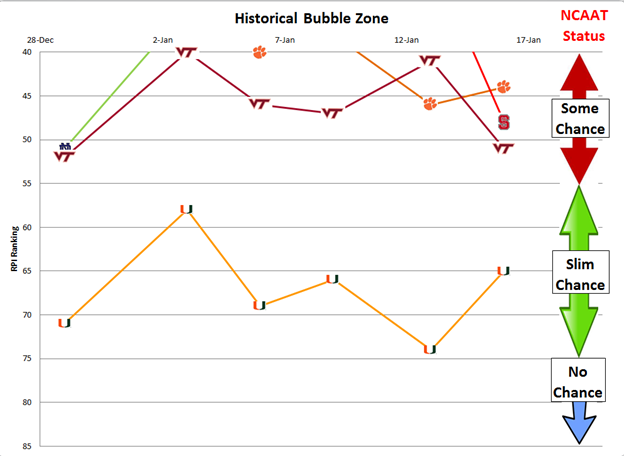
Clemson was the first team to drop from solidly IN to down on the Bubble followed quickly by State. They will have more company soon.
The ACC started conference play with the Bracketologists putting 8-10 ACC teams in the NCAAT. Today, it looks more like six.
ACC STANDINGS
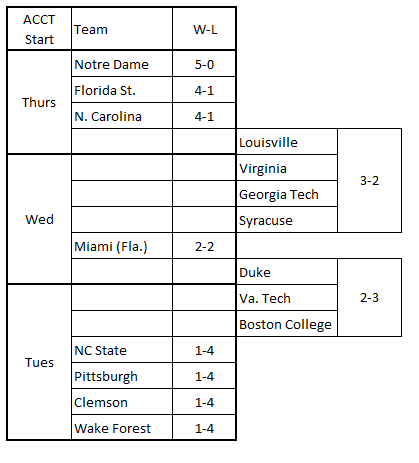
Based on RPI, both Syracuse and GT are pleasant surprises, while the bottom four are not.
UPCOMING ACC SCHEDULE
Let’s start this week’s wrap-up by correcting an error I made in the Jan 3 entry about State’s ACC schedule. Everyone knows that college basketball teams generally play two times per week and that ACC basketball has 15 teams. Obviously that means that each group of games (mid-week or weekend) has one team sitting out or playing an OOC game. I erroneously stated that State gets a break between the road games at Duke on 1/23 and at L’ville on 1/29. While there are six days between those games, calling it a break is analogous to saying that an NFL team that plays on Thursday night gets a break on the following Sunday. The Duke game is on Monday (ie mid-week game) and the L’ville game is on Sunday (weekend game)….thus no real break. It turns out that State sits out the very last Saturday and will have roughly a week between its final regular season game at Clemson on Wednesday and the start of the ACCT on Tuesday of the next week.
Last week State went 0-2 against what was supposed to be the bottom of the conference. This week they have two home games against teams (Pitt and WF) battling with State for a spot at the actual bottom before traveling to Durham. Here’s next week’s ACC schedule:
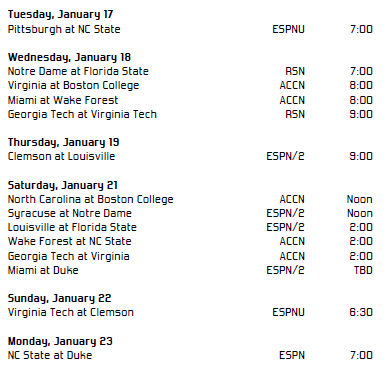
Other games of interest:
FSU hosts two more highly rated teams (ND and L’ville) concluding their “home stand” (five of their first seven ACC games being played in Tallahassee) with all seven teams ranked in the RPI Top 50. Obviously they’re going to hit the road hard in the second half of the season. Looking way ahead, FSU only plays GT, Syracuse, BC, State, WF, and Pitt once each which probably means that FSU will end up with one of the harder ACC schedules this year. FSU doubles up on Duke, ND, UM, and Clemson. So their exact schedule difficulty will depend on where Clemson and Miami end up in the conference standings.
The Walking Dead won’t start back until Feb, so I’ll probably watch VT at Clemson to get a better feel for both teams. Historically, Clemson plays well at home so a Clemson win might not mean much. But then again, it’s not like Sunday night TV is full of interesting alternatives.
If the creek don’t rise, I’ll do the next conference update after the Duke game on the 23rd.


